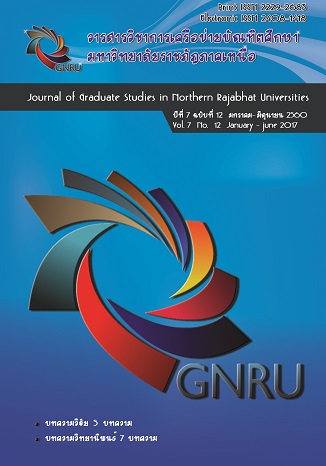การพัฒนาหลักสูตรฝึกอบรมเตรียมความพร้อมรับมือน้ำท่วมตามแนวคิดพี่สอนน้อง สำหรับนักเรียนในพื้นที่เสี่ยงภัย; The Development of Training Curriculum on Flood Preparedness Based on Peer Tutoring Approach for Students in Risk-Prone Areas
Main Article Content
Abstract
การวิจัยครั้งนี้มีจุดมุ่งหมายเพื่อสร้างและศึกษาผลการใช้หลักสูตรฝึกอบรมเตรียมความพร้อมรับมือ
น้ำท่วมตามแนวคิดพี่สอนน้อง สำหรับนักเรียนในพื้นที่เสี่ยงภัย กลุ่มเป้าหมาย ได้แก่ นักเรียนชั้นมัธยมศึกษาปีที่ 2 โรงเรียนบางระกำวิทยศึกษา อำเภอบางระกำ จังหวัดพิษณุโลก ปีการศึกษา 2557 จำนวน 28 คน ได้มาโดยการเลือกแบบเจาะจง ใช้เวลาทดลอง 12 ชั่วโมง การวิเคราะห์ข้อมูลโดยใช้ค่าเฉลี่ย ส่วนเบี่ยงเบนมาตรฐาน และการทดสอบค่าที และการวิเคราะห์เนื้อหา
ผลการวิจัยพบว่า
1. หลักสูตรฝึกอบรมเตรียมความพร้อมรับมือน้ำท่วมตามแนวคิดพี่สอนน้อง ประกอบด้วย
7 องค์ประกอบ คือ หลักการและเหตุผล จุดมุ่งหมายของหลักสูตร โครงสร้างของหลักสูตร เนื้อหาสาระ กิจกรรมการเรียนรู้ สื่อการเรียนรู้ และการวัดและประเมินผล หลักสูตรมี 4 หน่วยการเรียนรู้ ได้แก่ การอพยพหนีน้ำท่วม
การพายเรือ การปฐมพยาบาลคนจมน้ำ และการช่วยเหลือคนจมน้ำ โดยหลักสูตรฝึกอบรมมีความเหมาะสม
อยู่ในระดับมาก
2. นักเรียนมีความรู้ในการเตรียมความพร้อมรับมือน้ำท่วมหลังทดลองใช้หลักสูตรฝึกอบรมสูงกว่า
ก่อนเรียนอย่างมีนัยสำคัญทางสถิติที่ระดับ .05
3. นักเรียนมีทักษะในการเตรียมความพร้อมรับมือน้ำท่วมหลังทดลองใช้หลักสูตรฝึกอบรม คิดเป็น
ร้อยละ 71.83 ซึ่งสูงกว่าเกณฑ์ร้อยละ 60 อย่างมีนัยสำคัญทางสถิติที่ระดับ .05
4. นักเรียนมีการเปลี่ยนแปลง คือ มีสติ มีทักษะในการแก้ปัญหา มีภาวะผู้นำ มีความรับผิดชอบมากขึ้น
เกิดความผูกพันระหว่างกัน รุ่นพี่เห็นคุณค่าในตนเองที่ได้ช่วยเหลือรุ่นน้อง
Abstract
The research aimed at developing and studying the implementation results of the training curriculum on flood preparedness based on peer tutoring approach for students in risk-prone areas. The participants were 28 students of Mathayomsuksa 2 in Bangrakamwittayasuksa School, Bangrakam District, Phitsanulok Province and were selected by using purposive sampling technique. The duration of the experiment was 12 hours. The quantitative data were analyzed by using percentage, means and standard deviation and content analysis was used to analyze qualitative data.
The results revealed that:
1. The training curriculum on flood preparedness based on peer tutoring approach for students in risk-prone areas comprised 6 components including concepts, objectives, learning contents, learning activities, learning materials and learning assessments. The learning contents were divided into four units, namely flood evacuation, boating, first aid CPR, and rescue drowning man. The curriculum was considered feasible at a high level.
2. Students’ level of disaster preparedness knowledge after learning was higher than before learning at the .05 level of statistical significance.
3. Students’ disaster preparedness skill was at 71.83 percentage which was higher than the criterion score of 60 at the .05 level of statistical significance.
4. Students’ changes were as follows: the mindfulness, the problem solving skill, the leadership and commitment, the relationship between tutors and tutees. Tutors had acquired and expressed their self-esteem.

